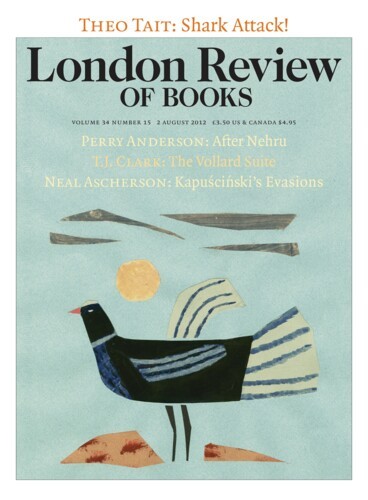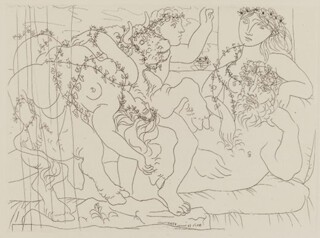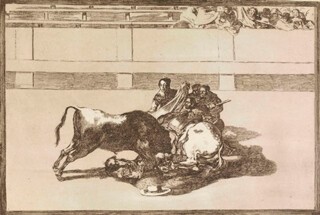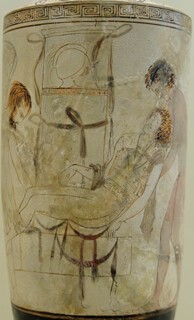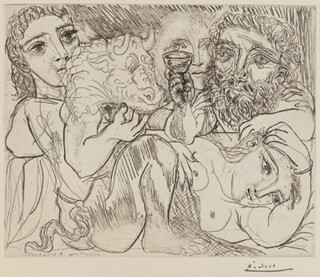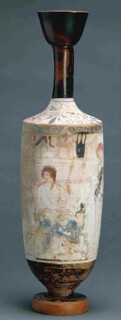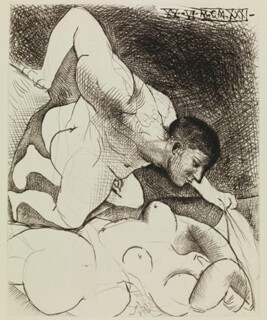The Vollard Suite is an entertainment. The hundred etchings Picasso produced between 1930 and 1937, which at some point became a set to be sold together, are – for want of a better word – courtly. In much the same way as Milton’s Comus, say, or Handel and Gay’s Acis and Galatea. The etchings are elegant, self-conscious, mostly light-hearted things, even when their subject matter is riotous or worse. In plate 56, for example, done on 30 March 1933, the elderly sculptor and his model, both naked and plumped up on pillows, gaze a bit vacantly at a marble the sculptor has been working on, in which two young dancers – bit players from a Bacchic sarcophagus – do the high-step with a bull. The animal is benevolent, not to say furry and fey; he holds up one foreleg daintily, so that the intersection of his cloven hoof with the sculptor’s nipple is entirely innocuous (like the model’s fingers in the old man’s chest hair); the bull and the woman he may be abducting are both tied up, not very convincingly, with strings of flowers; a curtain comes down on the performance as a gentle shower of rain. The model still has on her Bacchic garland, and the sculptor is dreaming of his days as a wild thing. (Picasso was 51 in 1933. Michel Leiris in his diary records a group of friends at the time gossiping about the decline in their hero’s sexual powers. The gossip sounds dreary, but Picasso was asking for it.)
Everything depends, in this etching and elsewhere through the series, on our taking the etching’s unseriousness seriously, or just seriously enough: getting involved in the tempo and pressure of the scene’s ultra-thin marks, and seeing in the etcher’s short-cutting certainty (the way the sculptor’s hand is done, for instance, or the scribbled flowers, or the long lines of the curtain, or the throwaway scratches that stand for mattress and bed) enough of pathos, or even of regret that nowadays only this kind of casual brilliance is possible – for a subject, after all, in which so much, for Picasso, was at stake. Art, sex, wildness, youth and age, attentiveness, tenderness, touch.
The Vollard Suite is an entertainment. There is no harm in that, and Picasso is the last artist to be uneasy or apologetic about just showing his stuff. He would have agreed with Matisse, who was asked in 1929 what he thought he was doing re-creating his world of odalisques and Moroccan back bedrooms each day, in a Europe on the road to hell. ‘Je fais des Odalisques pour faire du nu,’ he replied. ‘Mais comment faire du nu sans qu’il soit factice?’ I think the word ‘now’ is implied in the second sentence, as it constantly is in Picasso’s etchings. The further the world goes towards Hitler and Franco, the more absolute and counterfactual the dream. The blind minotaur is led through the underworld of 1934 by a little Alice in Wonderland cradling a dove, and in at least one of Picasso’s variations on her profile (number 96, from 23 October) I feel Humbert Humbert breathing too close. The studio, as the suite proceeds, becomes more and more an inner sanctum (like the dreadful interiors Picasso did in Paris in 1942, where paper-thin models wait for a bomb through the roof), keeping the least trace of reality at bay. Number 82 of the suite, 10 March 1934, is a kind of endpoint. Women’s bodies in it are entombed as much as immortalised by scratched shading that does not know when to stop. The statue laughs in its beard. The world through the window is like an extract from the background of Bruegel’s Triumph of Death.
I am trying to speak up for the series’ unseriousness, and suggesting that Picasso the etcher seems to have been waiting, at least some of the time, for the moment at which the world through the window – the scorched-earth landscape – would somehow be there in the dreamworld up front, pressing in on the place of reprieve. But it would be foolish to claim this happened very often. Stephen Coppel, the British Museum’s curator, has included here and there among the Vollard plates things from the museum’s collection that might help us take the measure of Picasso’s borrowing. There is a massive head of Hercules, a Greek vase featuring a minotaur, Etruscan mirror-backs with incised heroes, incomparable Rembrandts. (It is fitting that a wall label in the show quotes Picasso saying to Françoise Gilot: ‘Every painter takes himself for Rembrandt … Everybody has the same delusions.’) And then in among the femmes toreros and arenas with wounded bull-men – most of these subjects not Picasso at his best – the viewer comes across a plate from Goya’s Tauromaquia, a Picador Is Unhorsed and Falls under the Bull.
It is a cruel comparison, and maybe an unfair one. Goya’s feeling for the physical reality of the moment – the long seconds of helplessness and horror always shadowing the bullfight’s pas de deux – is way beyond Picasso’s reach. Just look at the light and emptiness in Goya’s etching (considered as metaphors for time suspended and pitiful vulnerability) and compare them with Picasso’s cursory backdrop. Just look at the onlookers in the front-row seats! Picasso was aware, of course, that he, like everyone else, could never match Goya’s disgust and compassion for the human and the animal and the human-as-animal. ‘The lantern is Death,’ Malraux remembers him saying of Goya’s Third of May. ‘Why? We don’t know. Nor did Goya. But Goya, he knew it had to be like that.’ The Spaniard was much on his mind. ‘Je vis plus avec lui qu’avec Staline,’ he said later – it must have been during his years as the PCF’s trophy card-holder.
The Tauromaquia is Goya’s territory. Picasso’s taste for the sport is, by comparison, pseudo-mythologised – Bataillesque. A fairer point of comparison for the 1930s etchings would be Goya’s Caprichos or Disparates, where (sometimes) the light fantastic does seem to be what the artist is trying for. But even here the comparison is crushing. Goya’s mind moved naturally – dangerously – into a world of malformations of the reality he was part of. Sadness and absurdity were his constant companions. He had seen the impossible (the unspeakable) happen. The sleep of Reason was no metaphor for him. Bringing such horrors into the realm of art – making them almost bearable, almost laughable – was his life’s work. None of this applies to Picasso. The half-sleep of Picasso’s inordinately calculating intelligence – which half-sleep he knew he needed, and envied in artists like Rimbaud, and looked around for ways to induce – did not bring forth monsters so much as freaks, fancies, charming passing grotesques. They were often astonishing, but never for real. When he said to Kahnweiler, ‘I believe in phantoms. They’re not misty vapours, they’re something hard. When you want to stick a finger in them, they react,’ he was only pretending to a worldview that Goya actually had.
In practice, no doubt, Picasso knew his limits. This is the Vollard Suite’s theme. The way out of calculating unseriousness, for him, was for his art to admit it fully – to relish it, to make it the etchings’ great burden. Therefore the hundred etchings had to be not just an entertainment but, worse, a classical entertainment; and worse still, a neoclassical entertainment, fully belonging to the interwar French faux-Mediterranean art world. The etchings would be, and declare themselves to be, a 1930s divertissement; fit to go in the room with Cocteau and Giraudoux and Maurice Denis murals and the reliefs on the Trocadero Palace. (Only those who had Giraudoux’s Amphitryon 38 inflicted on them at school will know the whole truth.)
How on earth, the question follows, did Picasso manage to escape from the double-locked coffin of Parisian good taste? The British Museum is the perfect place to think about this, because within minutes you can walk out from the print room and be in front of the Harpy tomb or a white-figure lekythos, and confront what the ‘classical’ was and the neoclassical was not. I went down to the rooms with the pick of Greek vases, and found myself (with the minotaur and the dreaming models in mind) stopped in front of a great fragile scene in which a young hero is borne off by Hypnos and Thanatos, and another vase, from a half-century later, where a disconsolate young woman sits, sealed by the look of it inside her own sepulchre, mourning the life of the blue in her frock, surrounded by unwelcome grave goods. The reader may say again, as with the Tauromaquia, that my comparisons are hard. What view of death has ever equalled these for delicacy and regret? But it is not the quality of emotion, or even of realisation, that seems to me relevant to Picasso. It is the Greek tone – the unseriousness.
No one is going to say (at least, I hope not) that the lekythoi paintings are simply light-hearted. They mourn and memorialise the dead. But this does not mean – my eyes and the scholarship seem to agree – that their mode (their ‘brief’) is at all easy to pin down. The whiteness and delicacy and spare touches of colour seem partly to stand for the thoughtlessness of life – the flounce of the frock, the beauty of the hero, the deference of slaves – persisting in the underworld. There is a lekythos next to the pair I illustrate where two young bloods are chasing a hare, for sport, through the tomb’s doorway.
It is the balance of affect here that seems to connect to Picasso’s etchings. Most neoclassicists, certainly in the 20th century, looked past the lekythoi to the (inimitable) stone gods. They thought classicism must mean, as Yeats had it, always trying to ‘climb to our proper dark, that we may trace/ The lineaments of a plummet-measured face’. They did not understand, or maybe sympathise with, the role of the flimsy and exquisite in Greek vase painting or Roman murals and stucco work, and above all they did not see that here, at the heart of the classical, a deliberately ‘decorative’ idiom was so often made, by the great craftsmen, to turn the corner into pathos. I think Picasso did.
Take number 92 of the Vollard Suite, 18 June 1933, done in a mixture of drypoint, etching, scraper and burin. It is, typically, a bit blowsy and ridiculous – bordering on the smug – but irresistible. The atmosphere is again of slightly worried thoughtfulness, a pause in the pantomime, the various players clinging on to a charged stillness, a physical present tense. Somehow the fingers and nails of the woman on the right, touching her breast almost tentatively, sum this up. The minotaur seems well-behaved, maybe simple-minded. His stubby fingers hold his bull’s head as if it were a mask in a carnival. The scraper has almost vapourised the face of the woman in the centre, but only the better to make her and her stare transfixing. The plate’s rectangle is full – a feast of different kinds of hatching and edging – but not busy. The moments of lightness and emptiness, above all in the woman lying down, are enough to quiet and stabilise the mood. It is lovely that the woman has a blanket to keep her warm.
All of this is on the edge of cliché. The Picasso way of doing women’s eyes and lashes, their fine noses and ‘classical mouths’, becomes cloyingly familiar as the hundred etchings go by. But I for one look at the model top left – the way her mouth is half-hidden by the minotaur’s spiky pelt, the way her eyelash overrules the liquid darkness next door – and utterly give in.
This being Picasso, and Paris in the 1930s, there are moments in the series when Humbert Humbert gives way to Sade. Notably, five plates of sexual intercourse, with the sculptor decidedly on top. The catalogue gently chides previous scholars for their titles (Picasso gave none): The Battle of Love, The Embrace and so on. Rape is the one now preferred. Maybe it is preferable, but it is still not good – not good because it is too sure of the name for its object. I am more or less with Andrea Dworkin on this: sexual intercourse, as we and Picasso know it, is a set of events in which violence, violation, absurdity of effort and exaltation, dreadfulness of submission, simple pain and embarrassment, general sweaty muddle are all ineluctably ‘in play’. The man’s face in number 29, for example, 2 November 1933, could hardly make it clearer that here nobody wins.
A drypoint done on 20 June 1931, number 5 (its mood is different from that of the series in general, and connects with a line of painting Picasso had underway around 1930), is as close to a ‘statement’ on such matters as Picasso ever got; and therefore as close as he ever came to creating a true Goya monster. Of course the monster is man, not bull. And maybe the key to man’s monstrosity – this is the drypoint’s thought – is his hairlessness. He lacks the animal’s saving disguise. The label in the exhibition talks about the scene’s being tender, and this is not wrong. It could be that men are capable of tenderness (sometimes) because they admire the harmony of a woman’s body in comparison with their own: the way hair and hairlessness are in balance in the female, not scattered at random or cultivated as fetish. (The beard of the man in the intercourse series is his most pathetic trait.)
It does not seem right to end with these exceptional painful plates, but inevitably in the print room one gravitates towards them. They give a sense of what, fundamentally, in Picasso, the light-heartedness was keeping at bay. The hunchback twitches the curtain aside. And there she is, the naked woman, at the immense distance beauty keeps from ugliness. Let me therefore show her musing and dreaming, time and again, and tie her up with flowers.
Send Letters To:
The Editor
London Review of Books,
28 Little Russell Street
London, WC1A 2HN
letters@lrb.co.uk
Please include name, address, and a telephone number.
